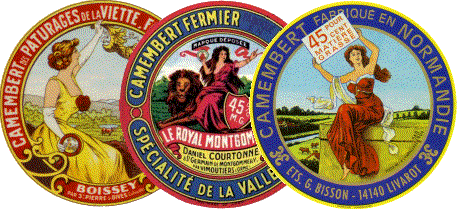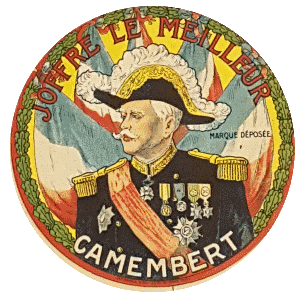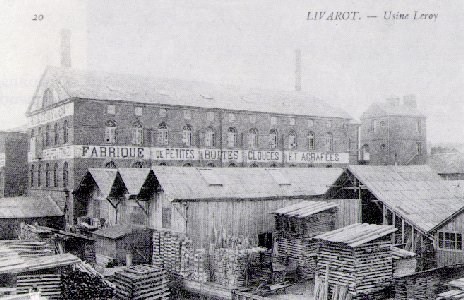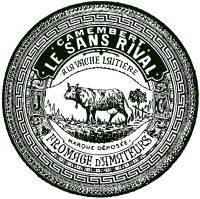
The good reputation of the camembert soon drew the world attention on that cheese. Therefore many anecdotes about the camembert have been collected over the years and complete amusingly its history. Even more, the camembert has got many fans (some collect the original labels). It has also been often associated with the beret, the bread ... as one of the supposed symbols of the French people.
Many anecdotes and facts that should be explained now...
History:
The official Camembert history as it is presented on the first page of this site, could seem a little extraordinary. Nevertheless there are other short stories in the long camembert history, that would seem even more incredible. Here are a few of them.
At the beginning:
From time to time, the part of Marie Harel in the creation of the Camembert is contested, but history will have to keep her name, as long as nobody can find a more accurate one.

Nevertheless, she is not only associated with the history of Camembert for its personal part. One of her descendants, Thomas Paynel, had also his "fifteen minutes of fame". In august 1863 he met Napoleon III in Surdon and offered him one of his cheese. Napoleon III was delighted with the taste of the cheese, and Thomas Paynel became the official furnisher of camembert of the french emperor. It helps him to create a new outlet for the camembert in Paris.
Thanks also to Victor Paynel, the Camembert also became in 1813 "citizen of the town of Caen"!
The camembert cheese met history one more time during World War I (1914-18). It was one of the components of the iron rations, that were given to the French soldiers. They also created an expression to define the behavior of the unexploded shells, they said that they "made a balls-up in Camembert" (in french "foirer dans le camembert")

Camembert Goes West:
At the eve of the 20th century, in 1926 an American citizen, Joseph Knirim went to Normandy and there, claimed that the camembert had cured him from his stomachaches. For this reason, he decided to pay homage to the camembert birthplace and started a fund for the erection of a statue. Thanks to his help, a Marie Harel's statue was erected in Vimoutiers and inaugurated by Mr Millerand..
But the stories went on... The statue was bombed down during the allies landings in Normandy in 1944. At the end of the war, a fund was started in the USA to rebuild the statue. A lot of Americans and especially the workers of the Borden's Cheese Company (Ohio) made an handsome contribution and soon the new statue was inaugurated.
The camembert and its box
Although the camembert taste is probably the main reason of its international celebrity, one must admit that the camembert box and its famous label also plays a major role in its success.
In the early days, the camemberts were sold (as many other cheeses) laid in straw cases on the market of the Auge country. Nevertheless soon it appeared that it didn't allow the camembert to be sold far from its dairy . Other solutions had to be found...
First the producers decided to wrap every camembert in a thin paper sheet, then to pile five of them up in a strong red sheet of paper ( with the brand of the camembert printed on it) and on both sides of the pile they added two hexagonal wood pieces. That solution was good enought to carry the camemberts into the different Norman markets, but it was still unefficient for long transports.
In the town of "Le Havre" around 1890, a french cheese exporter
(M. Rousset) decided to use spruce wood boxes already used in the Jura (a
low chain of mountains in the east of France) to export its camemberts. In
the same time, Eugène Ridel, who was said to be the inventor of the camembert
box in the first page of this site, worked on the creation of a "nailed
and stapled" poplar wood box. He probably shared that paternity with
Georges Leroy, the owner of a sawmill that became one of the biggest in Normandy
for the production of "camembert boxes".

The Leroy factory in Livarot (Old postcard)
The success came soon and it seems that at the beginning of the 20th century the use of that box was generalized. We should note that during that period the tin box was also used to wrap the camemberts that were sent in Great Britain. The "invention" of the camembert label closely followed the generalization of the used of the camembert box. It was prefered to other technologies, such as printing on wood, and the poker work.

One of the first registered camembert label
The "Sans Rival" in 1887
Camembert, quotes and masterpieces:
In a country, where it is often as important to speak about the cook than to really eat it; the camembert is bound to become the subject or one of the elements of many books, paintings etc...
Camembert in litterature
Brillat-Savarin, the well-known critic wrote these verses.
| Camembert, poésie, bouquet de nos repas, Que deviendrait la vie, Si tu n'existait pas? |
Camembert, poetry, Bouquet of our meals, What would become life, If you did not exist? |
Emile Zola described in 1873 one of the Paris cheese market in "Le ventre de Paris":
| [...]Le camembert, de son fumet de venaison, avait vaincu les odeurs plus sourdes du maroilles et du limbourg; il élargissait ses exhalaisons, étouffait les autres senteurs sous une abondance surprenante d'haleines gatés. | The camembert with its venison scent defeats the Marolles and limbourg dull smells; It spreads its exhalation, smothering the other scents under its surprising breath abundance. |
Pierre Chaine in "Mémoires d'un rat" (Memory of a rat) describes the life of the rat during the first world war. The hero, a rat called Ferdinand, became the mascot of the soldiers that offered it what every soldier would like to get:
| "On me donna de l'eau, du camembert et de la paille[...]²". | "They gave me water, camembert and some straw [...]" |
Clémenceau, " the Tiger", confirmed that opinion. When talking to the ex-servicemen of the "cote 504" in 1919 (a battlefield of World War I), he described the camembert as:
| "Cet autre ami des hommes aux heures difficiles". | "This other friend of men during the hard times" |
In 1919 Clémenceau, " the Tiger", talking to the ex-servicemen of the "cote 504" (a battlefield of World War I), described the camembert as:
| "Cet autre ami des hommes aux heures difficiles". | "This other friend of men during the hard times" |
Léon-Paul Fargues drew a surprising parallel...
| Devant un bon camembert à bonne et forte odeur, il s'exclama :"Les pieds du Bon Dieu !". | In front of a good camembert with a strong and pleasant smell, he declared :"God's feet". |
Franck Nohain created that famous quatrain, loved by the children:
| Membert languit Membert se meurt Ami si cher Mais qu'a Membert ? |
Difficult to translate it because there's a pun in it! |
Marcel Proust , who is famous for his "madeleine", explained in "Sodome et Gomorrhe II, II" the mistake of a lift attendant by the camembert fame...
| "Le lift me jura, avec la sincérité de la plupart des faux témoins mais sans quitter son air désespéré, que c'était bien sous le nom de Camembert que la marquise lui avait demandé de l'annoncer. Et à vrai dire, il était bien naturel qu'il eût entendu un nom qu'il connaissaît déjà. [...], le nom de Camembert lui avait paru d'autant plus vraisemblable que , ce fromage étant universellement connu, il ne fallait point s'étonner qu'on eût tiré un marquisat d'une renommée aussi glorieuse, à moins que ce ne fût celle du marquisat qui eût donné sa célébrité au fromage." | "The lift attendat swore, with the frankness of most of the lying witnesses but with a deseperate look, that the marchioness did ask him to use the name Camembert to announce her. And to be honest, it was natural that he did hear a name that he already knew. [...] the Camembert name seemed to him even more credible that this cheese is so universally famous, that no one would have been surprised if a marquisate name had been extracted from it, unless it had been the celebrity of the marquisate that made the cheese famous." |
Céline in one of his books "Mort à crédit" related how Gorloge (one of his character) left his familly to go to the army, and obviously in his haversack he put some camembert cheeses
| "Ainsi, il est descendu... Le petit Robert portait sa musette. Elle était sérieusement chargée, avec trois camemberts, et des "vivants" que tout le monde en faisait la remarque..." | "Then, like that, he went down...Little Robert was carrying its haversack It was quite loaded, with three camembert cheeses, that were so "alive" that everybody was noticing it..." |
In one of the Frédéric Dard (alias San-Antonio) book "Bérurier au sérail "(Bérurier in the seraglio) published in 1969, the eccentric Bérurier, became a zealous upholder of the camembert cheese in the middle of the desert (!):
| "- Messieurs et même mesdames, j'ai l'honneur de vous présenter en exclusivité, un produit de l'élevage français. J'ai surnommé le camembert authentique, véritable et pur fruit de Normandie [...] Il brandit son calendos de plus en plus coulant, comme un discobole superbe et généreux. On murmure dans l'assistance. Les gars se tâtent à cause de l'odeur [...] Et si je veux leur apprendre la civilisation, c'est mon droit, non?Dans les pays arriérés, y a plein de missionnaires qui vont brader notre bon Dieu, pourquoi t'est-ce que je leur refilerais pas nos camemberts?[...]". | "Gentlemen and even ladies, I am proud to present you an exclusive product of the french breeding. I name it: the camembert, the genuine and real product of Normandy.[...]. He waved the runny cheese, and he seemed as proud as a generous discobolus. The audience was mumbling but the customers seemed a bit afraid of the smell [...] (to his friends) In many countries, several missionaries are presenting God, why can't I present the camembert" |
Finally, father Etienne, Camembert parish priest, wrote this poetry to celebrate the camembert, this famous country product.
| CAMEMBERT n'est pas seulement un fromage, C'est surtout un joli village Qui un jour donna son nom A cette pâte de grand renom. Voulez-vous en savoir l'histoire? Elle est simple, il faut me croire: Au manoir de Beaumoncel, Habitait Marie Harel. C'était une humble fermière, Ici, toutes les femmes en sont fières. C'est elle, qui de ses mains le créa Aidé d'un prêtre, qu'elle cacha. Fuyant la tourmente révolutionnaire, Il avait chez elle trouvé repaire, Voyant combien vaillament elle trimait Il lui dit comment l'affiner. Ce fut pour elle sa récompense. Ici, le camembert a donc pris naissance. Bien sûr, on le fabrique maintenant partout: Dans toute l'Europe, en Amérique, plus loin encore je ne sais où, Mais ici, de Marie Harel, ce n'est pas un rêve, Deux fermiers ont pris la relève. Si vous êtes un peu gourmands, Chez l'un et l'autre vous le trouverez excellent. |
CAMEMBERT is not only a cheese, It's above all a nice village That one day gave its name To this reknown cheese. Do you want to know its history? It's simple, you should trust me: In the Beaumoncel manor Lived Marie Harel. She was a humble farmer, Here, all the women are proud of her. It's her who created it, Helped by a priest, she was hiding. Fleeing the revolution upheaval, He found a refuge there. Seeing how bravely she was working, He told her how to mature it. It was her reward. Here, the camembert was born. Of course now, it is made every where: In the whole Europe, in America, even farther... But here, It's not a dream, Two farmers took over from Marie Harel. If you are a bit greedy By both of them, you'll find it excellent |
Camembert in music
Some musicians have been inspired by the camembert and even if there is no opera dedicated to the camembert, there are many songs and albums that evoke the camembert cheese.
For example a least two bands have names related to the camembert. "Citizen Camembert" plays music on traditional instruments and "Monsieur Camembert" is an australian band that plays music inspired by the gypsy, jazz and classical music.
The camembert is obviously also evoked in the counting ryhme sung by the chidren (for example the one written by Henri Dès "j'attends maman, j'attends papa"), and rather obscure songs such as the "camembert dance" ("La danse du camembert") by Big Mamma. In terms of rock music the album "Camembert électrique" was published in 1969 by Gong. That album also inspired the title of the Five Fifteen album: "Six dimensions of the electric camembert".
Finally, the camembert is evoked in several other songs:
Boris Vian, in the song "J'suis snob" (I'm snob), pretend that the snobs have a curious way of eating camembert cheese.
| On se réunit Avec les amis Tous les vendredis Pour faire des snobisme-parties Il y a du coca On déteste ça. Et du camembert Qu'on mange à la petite cuiller. |
We meet With friends Every Thrusday For Snob parties. There's Coca-Cola We hate that. And Camembert That we eat with spoons |
Boby Lapointe also evoked the camembert cheese in the song "Aragon & Castille"
| ...Et j'ai mangé pour tout dessert du camembert Le camembert c'est bon quand c'est bien fait Viv' l'amour... |
... My only dessert was a camembert The camembert cheese, it's good when it is matured Cheers for love... |
Michel Legrand et Jacques Demy in the famous film "Les parapluies de Cherbourg"
| [...] Nous sommes deux soeurs jumelles, Nées sous le signe des Gémeaux, Mi fa sol la, mi ré, Ré mi fa sol sol sol ré do Aimant la ritournelle, Le camembert et les bonbons.[...] |
.[...] We are two twin sisters And we are Gemini we love ritornello, Camembert and sweets. [...] |
In 1930, "You're the top", a famous Cole Porter song evokes the camembert in its fourth chorus
[...]You're the top! You're an Arrow collar.
You're the top! You're a Coolidge dollar.
You're the nimble tread of the feet of Fred Astaire
You're an O'Neill drama, You're Whistler's mama,
You're camembert [...]
Jacques Dutronc considère qu'il n'y a rien de plus approprié pour décrire le coeur d'un "dragueur de supermarchés"
| [...] C'est le dragueur de supermarchés, Celui qui porte les paniers Et qui s'occupe, et qui s'occupe, et qui s'occupe de vos bébés! Le Don Juan des ménagères avec son coeur de camembert [...] |
.[...] He is the supermarket chat-up merchant The one who carries the bags And who cares, who cares , who cares about your babies! He is the household Don Juam with his camembert heart [...] |
Camembert and the fine arts.
Salvador Dali gave to the camembert an architectural dimension:
| New-York est un roquefort gothique, San Francisco me fait penser à un camembert roman. |
New York is a gothic roquefort, San-Francisco reminds me of a romanesque camembert. |
|||
Dali also explained in "Secret life" that he had the idea of the soft watches, that appear in the the famous "Persistence of memory", after having eaten a camembert cheese for dinner.
Cartoonists were also inspired by that cheese. Georges Colomb (alias Christophe), one of the father of the French comics, created at the beginning of the 20th century, the Sapeur Camember(t) character. The parodic character SuperDupont, created by Gotlib goes further, and uses a lot of camemberts (generally as a weapon!). Lately Frank Margerin's character, Ricky, visited the United States and brought with him a camembert. The famous character, Achille Talon, has a neighbour, Lefuneste, who collects the Californian camembert cheese label... Notice that Achille Talon's father gives that piece of advice to Lefuneste "[...] obviously never eat californian camembert cheeses"!
Finally during the 80s, Joël Hubaut and more than forty other artists founded a group called "Les enfants du Camembert" (The children of the camembert). Their works were inspired by the Normandy and were often related to the Camembert cheese (like for example the ones presented in Hubaut's showing "Pyramide-camembert-rock & roll").
More About Camembert:
Every year on Easter Tuesday since 1934, a cycle race, Paris-Camembert, takes place between Magnanville and Vimoutiers (approximately 200km).
We can also evoke the "camembert throwing", a "sport" that was also created by Joël Hubaut. The record is nowadays above 40 meters.
